
Honeysuckles are arching shrubs or twining vines in the family Caprifoliaceae, native to northern latitudes in North America and Eurasia. Approximately 180 species of honeysuckle have been identified in North America and Eurasia. Widely known species include Lonicera periclymenum, Lonicera japonica and Lonicera sempervirens. L. japonica is an aggressive, highly invasive species considered as a significant pest on the continents of North America, Europe, South America, Australia, and Africa.
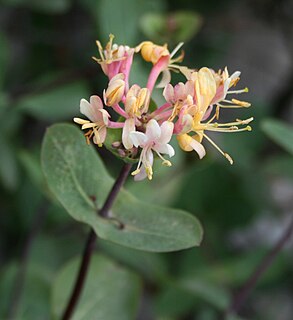
Lonicera etrusca is a species of honeysuckle known by the common name Etruscan honeysuckle. It is native to Europe and it is known elsewhere, including the Pacific Northwest of North America, as an introduced species where it has escaped cultivation. It is kept in gardens as an ornamental plant.
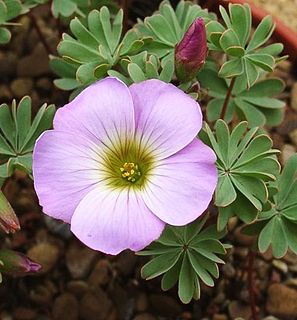
Oxalis enneaphylla, scurvy grass, is a late spring- and summer-flowering, rhizomatous, alpine perennial herbaceous plant native to the grasslands of Patagonia and the Falkland Islands. It is a small plant that grows to 7 cm (2.8 in) high and 10 cm (3.9 in) across, with slightly fleshy, hairy, blue-grey leaves, which are edible but have a sharp taste due to their high oxalic acid content. The name enneaphylla comes from the Greek εννεα (ennea), "nine" and φυλλον (phyllon), "leaf".

Nicotiana sylvestris is a species of flowering plant in the nightshade family Solanaceae, known by the common names woodland tobacco, flowering tobacco, and South American tobacco. It is a perennial plant in the tobacco genus Nicotiana, native to the Andes region in Argentina and Bolivia, in South America.

Geranium sylvaticum, the wood cranesbill or woodland geranium, is a species of hardy flowering plant in the family Geraniaceae, native to Europe and northern Turkey.
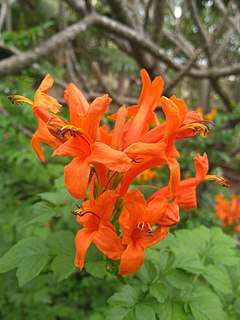
Tecoma capensis, the Cape honeysuckle, is a species of flowering plant in the family Bignoniaceae, native to southern Africa. Despite its common name, it is not closely related to the true honeysuckle.

Lonicera xylosteum, commonly known as fly honeysuckle, European fly honeysuckle, dwarf honeysuckle or fly woodbine is a deciduous shrub. It is one of two honeysuckles native to Britain, the other being the common honeysuckle.
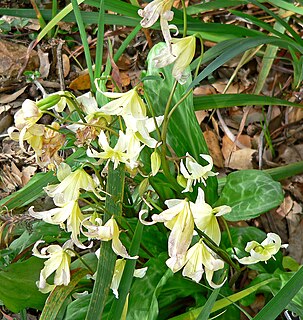
Erythronium californicum, the California fawn lily, is a species of flowering plant in the family Liliaceae, endemic to moist woodland habitats in the mountains of Northern California.
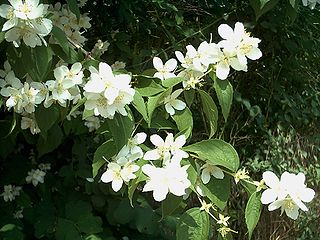
Philadelphus coronarius is a species of flowering plant in the family Hydrangaceae, native to Southern Europe. It is a deciduous shrub growing to 3 m (10 ft) tall by 2.5 m (8 ft) wide, with toothed leaves and bowl-shaped white flowers with prominent stamens. In the species the blooms are abundant and very fragrant, but less so in the cultivars. It may resemble, but is not related to, varieties of the similarly named dogwood, which is the common name for Cornus in the family Cornaceae.

Leucanthemella is a genus of flowering plants in the sunflower/daisy family Asteraceae.

Lonicera nitida is a species of flowering plant in the honeysuckle family. In English, it is sometimes given the common names box honeysuckle or Wilson's honeysuckle. It is widely used as a low hedging plant, and for topiary. It is also a popular low-maintenance ground cover plant for urban landscaping.

Sarcococca confusa, the sweet box, is a species of flowering plant in the family Buxaceae, probably native to western China. It is an evergreen shrub growing to 2 m (7 ft) tall by 1 m (3 ft) broad, with glossy green ovate leaves and honey-scented white flowers in winter, followed by glossy black spherical fruits, 5 mm in diameter.

Colchicum speciosum is a species of flowering plant in the family Colchicaceae, native to mountainous areas of northern Turkey, the Caucasus and northern Iran. Growing to 18 cm (7 in) tall by 10 cm (4 in) wide, it is an herbaceous perennial growing from corms. C. speciosum blooms in the fall, producing reddish/violet flowers on stems up to 30 centimetres (12 in) tall without any leaves present. The strap-like leaves grow in the spring, then yellow, wither and die back as summer progresses. The flowers strongly resemble those of the crocus, the familiar spring-flowering bulb; hence the common name autumn crocus which is applied to this and other colchicum species. However the two genera belong to different families; and there is in fact an autumn-flowering crocus species, Crocus sativus, the source of the spice saffron. By contrast, all parts of Colchicum speciosum are toxic if ingested.
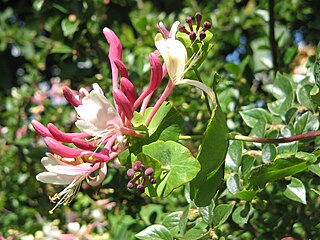
Lonicera caprifolium, the Italian woodbine, perfoliate honeysuckle, goat-leaf honeysuckle, Italian honeysuckle, or perfoliate woodbine, is a species of perennial flowering plants in the genus Lonicera of the family Caprifoliaceae. It is native to parts of Europe, and naturalised in South East Britain and northeastern North America. It can readily be distinguished from Europe's most common species, Lonicera periclymenum, by its topmost leaves, which are perfoliate as the Latin name suggests. It is a vigorous, deciduous climber growing up to 8 metres. It bears masses of very fragrant, cream-coloured flowers, tinged with pink, appearing in midsummer.

Azara microphylla, the boxleaf azara, is a species of flowering plant in the willow family Salicaceae, native to Chile and Argentina. Growing to 10 metres (33 ft), it is a small, upright, evergreen tree or large shrub. It has small, shiny, very dark green leaves and tiny, vanilla-scented flowers in winter. It is the hardiest of the azaras, withstanding temperatures down to −15 °C (5 °F), but in cooler temperate regions requires some protection from cold winds. It also tolerates full shade.
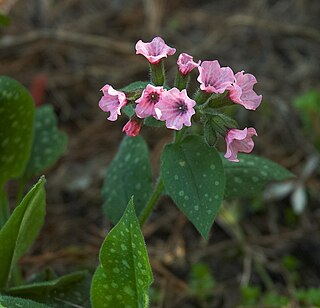
Pulmonaria saccharata, the Bethlehem lungwort or Bethlehem sage, is a species of flowering plant in the family Boraginaceae, native to France and Italy. It is a rhizomatous herbaceous perennial which is closely related to the common lungwort. Growing to 10 cm (4 in) tall by 60 cm (24 in) wide, it has lance-shaped leaves with white confluent spots, and pink or white flowers in spring.

Daphne pontica, commonly known as twin-flowered or Pontic daphne, is a species of flowering plant in the family Thymelaeaceae, native to Bulgaria, northern Turkey and the Caucasus. It is a small evergreen shrub growing to 1 m tall by 1.5 m wide, with leathery leaves and clusters of fragrant yellow flowers in pairs, in spring. The flowers are often followed by black berries. It tolerates deep shade in the garden, but dislikes transplanting.

Eucryphia glutinosa, the brush bush or nirrhe, is a species of flowering plant in the family Cunoniaceae, native to moist woodland habitats in Chile. It is a large deciduous shrub or small tree, growing to 10 m (33 ft) tall by 6 m (20 ft) wide, with glossy dark green leaves turning red in autumn. Single four-petalled, fragrant white flowers with prominent stamens appear in late summer.

Primula marginata, the silver-edged primrose, is a species of flowering plant in the family Primulaceae, native to the European Alps. It is an evergreen or semi-evergreen perennial growing to 15 cm (5.9 in) tall by 30 cm (12 in) broad, with rosettes of leathery serrated leaves, and stalks bearing umbels of slightly scented lavender flowers in spring. Parts of the plant, including the edges of the leaves, may be covered by a mealy-white bloom, hence the Latin and common names.
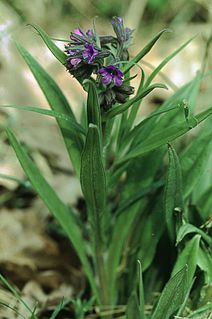
Pulmonaria angustifolia is a species of flowering plant in the family Boraginaceae, native to central and north eastern Europe. Growing to 30 cm (12 in) tall by 45 cm (18 in) broad, it is an herbaceous perennial with hairy oval leaves and masses of bright blue flowers in spring. The subspecies azureus has brighter blue flowers.





















